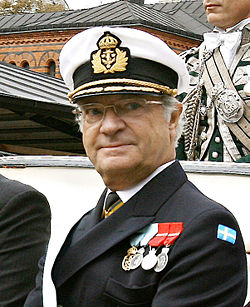Carl XVI Gustaf of Sweden
|
||||||||||||||||||||||||||||||||||||||||||
|
||||||||||||||||||||||||||||||||||||||||||
|
||||||||||||||||||||||||||||||||||||||||||
Carl XVI Gustaf (Carl Gustaf Folke Hubertus; born 30 April 1946) has been King of Sweden (Swedish: 'Sveriges Konung') since 15 September 1973. He is the only son of the late Prince Gustav Adolf, Duke of Västerbotten and Princess Sibylla of Saxe-Coburg and Gotha. He ascended the throne upon the death of his grandfather, King Gustav VI Adolf.
Contents |
Birth and early life
Carl Gustaf was born at Haga Palace ("Haga Slott") ("Kungliga Hovförsamlingen"), Solna, Uppland. He was christened at the Royal Chapel on 7 June 1946 by the Archbishop of Uppsala, Erling Eidem, and was given the title of Duke of Jämtland.
His godparents were The Crown Prince of Denmark, The Crown Princess of Denmark, The Crown Prince of Norway, Princess Juliana of the Netherlands, King Gustaf V of Sweden, Prince Friedrich Josias of Saxe-Coburg and Gotha, The Crown Prince of Sweden, The Crown Princess of Sweden, Count Folke Bernadotte af Wisborg and Countess Maria Bernadotte af Wisborg.
Youth and education
Prince Carl Gustaf Folke Hubertus was the youngest of five children and the only son of Sweden's Prince Gustaf Adolf and Princess Sibylla. His father's death in an airplane crash outside Copenhagen, Denmark, on 26 January 1947 left the nine-month-old Prince second in line for the throne, behind his grandfather, then Crown Prince Gustaf Adolf. When his great-grandfather King Gustaf V died in 1950, the four-year-old Prince became heir apparent of Sweden.
In a speech[1] in 2005, the King expressed some of his feelings about growing up without having known his father. His sister, Princess Birgitta, elaborated on these feelings in an interview around the same time, commenting that their mother and the strict Swedish royal court of the time didn't consider the emotional needs of Prince Gustaf Adolf's children. In that era, she said, tragedy was seldom discussed with children. "Children’s questions were met with silence, children’s anxiety and fear with the same silence."
As a result, Crown Prince Carl Gustaf was seven years old before he had been told about his father's death. "It was Mother’s way of handling the situation, to handle living her life. Of course it was not good for us children. It would have been much better to be able to speak about Father’s death," continued Princess Birgitta. She said it had been difficult for the future King to come to grips with not having a father and of not having the same memories of him as his older sisters.
After graduating from high school, the Crown Prince completed two and a half years of education in the Royal Swedish Army, the Royal Swedish Navy, and the Royal Swedish Air Force. He received his commission as an officer in all three services in 1968, and he eventually rose to the rank of Captain (Army & Air Force) and Lieutenant (Navy), before he ascended the throne. He has also completed academic studies in history, sociology, political science, tax law, and economics at the universities of Uppsala and Stockholm.
To prepare for his role as the Head of State, Crown Prince Carl Gustaf followed a broad program of studies on the court system, social organisations and institutions, trade unions, and employers' associations. In addition, he closely studied the affairs of the Riksdag, Government, and Ministry for Foreign Affairs. The Crown Prince also spent time at the Swedish Mission to the United Nations and the Swedish International Development Cooperation Agency (SIDA), worked at a bank in London, the Swedish Embassy in London, the Swedish Chamber of Commerce in France, and at the Alfa Laval company factory in France.
King
On 15 September 1973, Carl Gustaf became King of Sweden upon the death of his grandfather, King Gustaf VI Adolf. He was invested as King, at the Hall of State of the Royal Palace of Stockholm on 19 September 1973. King Gustaf VI Adolf was the last who used the style By the Grace of God King of the Swedes, the Goths/Geats and the Wends (Swedish: med Guds Nåde Sveriges, Götes och Wendes Konung; Latin: Dei Gratia Suecorum, Gothorum et Vandalorum Rex). This traditional title had been in use since the establishment of the hereditary monarchy in 1544. Carl XVI Gustaf instead chose the plain and simple title King of Sweden (Swedish: Sveriges Konung), thereby ending an age-old tradition.[2]
Such innovations are reflected in his personal motto För Sverige, i tiden, "For Sweden, with the times".
Marriage and family
The king married the half-Brazilian daughter of a German businessman. Silvia Sommerlath met the then-Crown Prince at the 1972 Summer Olympics in Munich, where she was an interpreter and host. The wedding was held 19 June 1976 at Stockholm Cathedral ("Storkyrkan Cathedral") ("Kungliga Hovförs") in Stockholm, and the ceremony was performed by the Archbishop of Uppsala, Olof Sundby. The King and his family reside at Drottningholm Palace outside of Stockholm since 1980 and use the Royal Palace of Stockholm as their workplace.
They have three children:
- Victoria, Crown Princess of Sweden, Duchess of Västergötland (1977– )
- Prince Carl Philip, Duke of Värmland (1979– )
- Princess Madeleine, Duchess of Hälsingland and Gästrikland (1982– )
Prince Carl Philip was born heir apparent. However, a constitutional reform that was already under way at the time of his birth made his older sister, Victoria, the Crown Princess and heiress-apparent on 1 January 1980, according to the principles of equal primogeniture, which Sweden was the first country to adopt.[3]
Kinship with European counterparts
The king is related to all current European reigning monarchs (at least through John William Friso, Prince of Orange, the most recent common ancestor of today's reigning European royal houses):
- Queen Margrethe II of Denmark - cousin
- King Harald V of Norway - double third cousin and second cousin once removed
- King Juan Carlos I of Spain - double third cousin
- King Albert II of Belgium - second cousin once removed
- Queen Beatrix of the Netherlands - third cousin
- Queen Elizabeth II of the United Kingdom - double third cousin
- Grand Duke Henri of Luxembourg - third cousin
- Prince Albert II of Monaco - seventh cousin
- Prince Hans-Adam II of Liechtenstein - sixth cousin once removed
Royal duties and personal interests
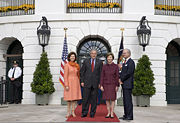
The King's duties are, according to Regeringsformen, of a representative and ceremonial nature. He pays State Visits abroad and receives those to Sweden, opens the Annual Session of the Parliament, chairs the Special Council held during a change of Government, holds regular Information Councils with Ministers, chairs the meetings of the Foreign Affairs Council, and receives and signs Letters of Credence of foreign ambassadors to Sweden and signs those of Sweden to foreign nations. The King holds the highest ranks in the three branches of the Swedish Armed Forces à la suite according to the Constitution.
Worldwide, Carl XVI Gustaf is probably best known as the presenter of the Nobel Prizes each year. He also hands over the Polar Music Prize. The King holds honorary doctoral degrees from the Swedish University of Agricultural Sciences, Royal Institute of Technology, Stockholm School of Economics and from Åbo Akademi University in Finland.
In connection with his state visit to the United Kingdom in the summer of 1975, he was appointed an honorary Admiral in the Royal Navy by Queen Elizabeth II, with seniority of 25 June 1975.[4]
The King is passionate about the environment, technology, agriculture, trade, and industry.
Like many members of the Royal Family, the King has a keen interest in automobiles. He owns several Porsche 911s — a car model which is said to be a particular favorite of the King — as well as a vintage Volvo PV444, a Ferrari 456 MGT, an authentic AC Cobra and other cars.[5] The first pictures taken of him and his future wife were of them sitting in his Porsche 911. In the summer of 2005 he was involved in a traffic accident in Norrköping. The accident was described as a "fender bender", with no serious personal injuries claimed. Nevertheless, the incident caused national headlines.[6]
In 2005 the King made a personal and passionate speech about the 2004 Indian Ocean tsunami, which had led to the death of over 500 Swedes.
Scouting
The King is the Honorary Chairman of the World Scout Foundation, and often participates in Scout activities both in Sweden and abroad. The King visits regularly World Scout Jamborees, for instance in 2002 in Sattahip, Thailand, and 2007 in Hylands Park, England. He attended the 1981 National Scout Jamboree in Virginia, USA, and was awarded the Bronze Wolf, the only distinction of the World Organization of the Scout Movement, awarded by the World Scout Committee for exceptional services to world Scouting, in 1982.
Biofuels research
The King attended the Sweden-Michigan Clean Energy Summit at the Ritz-Carlton Hotel in Dearborn, Michigan, on September 26, 2008, at the start of a two-day visit to Michigan. He also traveled to Kettering University in Flint, Michigan, for the ceremonial groundbreaking for a biogas plant that will be, when completed, similar to a biogas plant in Linköping, Sweden. On the second day of his visit he toured the test tracks of the Ford Motor Company and General Motors Corporation.[7]
Titles, styles and honours
Title
The King’s current title is simply His Majesty The King of Sweden. He also holds the personal title of Duke of Jämtland.
Style of reference
Carl XVI Gustaf is usually referred to as simply "the King" (Swedish: Kungen). In formal events and protocols, he is however entitled to "Your Majesty" (Swedish: Ers Majestät) or "His Majesty the King" (Swedish: Hans Majestät Konungen).
Royal and State Orders received
 Lord and Master (and Knight) of the Order of the Seraphim
Lord and Master (and Knight) of the Order of the Seraphim Lord and Master (and Commander Grand Cross) of the Order of the Sword
Lord and Master (and Commander Grand Cross) of the Order of the Sword Lord and Master (and Commander Grand Cross) of the Order of the Polar Star
Lord and Master (and Commander Grand Cross) of the Order of the Polar Star Lord and Master (and Commander Grand Cross) of the Order of Vasa
Lord and Master (and Commander Grand Cross) of the Order of Vasa Lord and Master (and Knight) of the Order of Charles XIII
Lord and Master (and Knight) of the Order of Charles XIII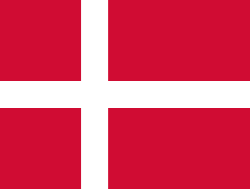 Knight with Collar of the Order of the Elephant
Knight with Collar of the Order of the Elephant Grand Commander of the Order of the Dannebrog
Grand Commander of the Order of the Dannebrog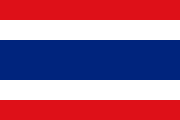 Order of the Rajamitrabhorn
Order of the Rajamitrabhorn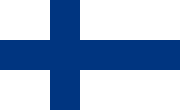 Commander Grand Cross of the Order of the White Rose
Commander Grand Cross of the Order of the White Rose Grand cross with Collar of the Order of the Falcon
Grand cross with Collar of the Order of the Falcon Grand Cross with collar of the Royal Norwegian Order of St. Olav
Grand Cross with collar of the Royal Norwegian Order of St. Olav Grand Cross of the Order of Leopold
Grand Cross of the Order of Leopold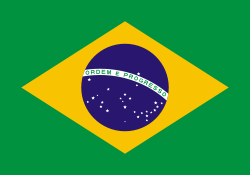 Grand Collar of the Order of the Southern Cross
Grand Collar of the Order of the Southern Cross Collar of the Order of the Cross of Terra Mariana
Collar of the Order of the Cross of Terra Mariana Grand Cross of the Légion d'honneur
Grand Cross of the Légion d'honneur Grand Cross of the Order of Merit of the Federal Republic of Germany
Grand Cross of the Order of Merit of the Federal Republic of Germany Grand Cross of the Order of the Redeemer
Grand Cross of the Order of the Redeemer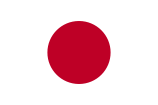 Collar of the Order of the Chrysanthemum
Collar of the Order of the Chrysanthemum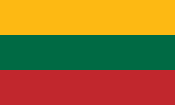 Grand Cross of the Order of Vytautas the Great
Grand Cross of the Order of Vytautas the Great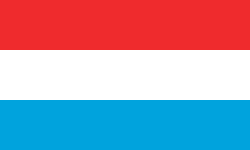 Grand Cross of the Order of Adolph of Nassau
Grand Cross of the Order of Adolph of Nassau Collar of the Order of the Aztec Eagle
Collar of the Order of the Aztec Eagle Grand Cross of the Order of the Netherlands Lion
Grand Cross of the Order of the Netherlands Lion Grand Cross of the Order of the House of Orange
Grand Cross of the Order of the House of Orange Grand Cross of the Order of the White Eagle
Grand Cross of the Order of the White Eagle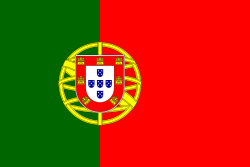 Grand Cross of the Order of the Tower and Sword
Grand Cross of the Order of the Tower and Sword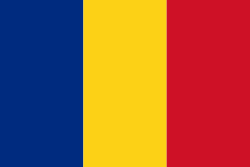 Sash Rank of the Star of Romania
Sash Rank of the Star of Romania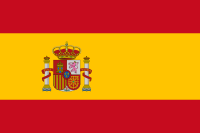 1,183rd Knight and Collar of the Order of the Golden Fleece in 1983
1,183rd Knight and Collar of the Order of the Golden Fleece in 1983 Grand Cross Collar of the Order of Charles III and Saint Fernando
Grand Cross Collar of the Order of Charles III and Saint Fernando Stranger 967th Knight of the Order of the Garter
Stranger 967th Knight of the Order of the Garter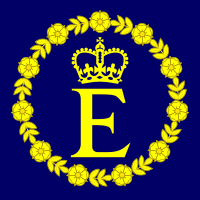 Recipient of the Royal Victorian Chain
Recipient of the Royal Victorian Chain
Other honours
 Honorary Admiral of the Royal Navy (Seniority: 25 June 1975)
Honorary Admiral of the Royal Navy (Seniority: 25 June 1975)
Patronages
- African Medical and Research Foundation Sweden (AMREF)
- Allmänna Idrottsklubben (AIK)
- Barnens Dags Riksförbund
- Centralföreningen för Idrottens Främjande i Sverige
- Djurgårdens Hembygdsförening
- Friends of the Nationalmuseum
- Friends of the Swedish Museum of Natural History
- Friluftsfrämjandet
- Föreningen Svenska Atheninstitutets Vänner
- Föreningen Konstnärernas Vänner
- Föreningen för Svenskar i Världen
- Gastronomiska Akademien
- Gripsholmsföreningen
- Idrottsföreningen Kamraterna (IFK)
- Kulturen i Lund
- Kungl. Automobil Klubben
- Kungl. Motorbåt Klubben
- Kungl. Svenska Aeroklubben
- Kungl. Svenska Segel Sällskapet
- Riksföreningen mot Cancer
- Royal Physiographic Society in Lund
- Royal Society of Sciences and Letters in Gothenburg
- Royal Society of Sciences in Uppsala
- Royal Swedish Academy
- Royal Swedish Academy of Agriculture and Forestry
- Royal Swedish Academy of Arts
- Royal Swedish Academy of Engineering Sciences
- Royal Swedish Academy of Letters, History and Antiquities
- Royal Swedish Academy of Music
- Royal Swedish Academy of Sciences
- Royal Swedish Society of Naval Sciences
- Royal Swedish Academy of War Sciences
- Rädda Visby Ringmur-aktionen
- Stiftelsen Det Naturliga Steget
- Stiftelsen Drottningholmsteaterns Vänner
- Stiftelsen Håll Sverige Rent
- Stiftelsen Stockholm Water Foundation
- Stiftelsen Svenska Flaggan
- Stiftelsen Svensk Våtmarksfond
- Stockholms Konserthusstiftelse
- Stockholms Studentsångarförbund
- Svenska Arkeologiska Samfundet
- Svenska Blå Stjärnan
- Svenska Djurskyddsföreningen
- Svenska Jägareförbundet
- Svenska Kennelklubben
- Svenska Livräddningssällskapet - Simfrämjandet
- Svenska Motionsdagen (Korpen Svenska Motionsidrottsförbundet)
- Svenska Rominstitutets Vänner
- Svenska Turistföreningen
- Svenska Scoutförbundet och Svenska Scoutrådet
- Svenska Sällskapet för Antropologi och Geografi
- Sverige-Amerika Stiftelsen
- Sveriges Allmänna Konstförening
- Sveriges Hembygdsförbund
- Sveriges Riksidrottsförbund
- Sveriges Skogsvårdsförbund
- Swedish Bible Society
- Swedish Lions
- Swedish Red Cross
- Swedish Rotary
- Sångsällskapet Orphei Drängar
- The American-Scandinavian Foundation
- Wilhelm Peterson-Berger Society
- World Scout Foundation
- World Wide Fund for Nature Sweden (WWF)
- Östasiatiska Museets Vänner
Dyslexia
For many years, it was widely rumoured that the king had dyslexia. Journalists noted that he misspelled his name when signing his accession document, and in 1973, when visiting a copper mine in Falun, he misspelled his name as "Cal Gustf" when signing it on a rock wall. In an interview on Swedish television in 1997, however, the condition was admitted publicly when his wife addressed the issue. "When he was little, people did not pay attention to the problem," she said. "He didn't get the help he needed." She also noted that the couple's children have "a bit of" dyslexia themselves.
Regnal name
In the 16th century, Johannes Magnus constructed a mythical line of Swedish kings, beginning with Magog, the son of Japheth, to demonstrate the antiquity of the Swedish throne. On the basis of his list, Eric XIV and Charles IX adopted their high ordinals; previous monarchs with those names are traditionally numbered counting backward from Eric XIV and Charles IX. The King of Sweden is therefore called Carl XVI Gustaf (Charles XVI Gustav) rather than Carl X Gustaf, although there are only nine known Swedish kings bearing the name Carl before him.[8]
Ancestors
| Ancestors of Carl XVI Gustaf of Sweden | ||||||||||||||||||||||||||||||||||||||||||||||||||||||||||||||||||||||||||||||||||||||||||||||||||||||||||||||||||||||||||||||||||||||||||||||||||||||||||||||||||||||||||||||||||||||||||||||||||||||||||||||||||||||||||||||||||||||||||||||||||||||||||||||||||||||||||||||||||||||||||||||||||||||||||||||||||||||||||||||||||||||||||||||||||||||||||||||||||||||||||||||||||||||||||||||||||||||||||||||||||||||||||||||||||||||||||||||||||||||||||||||||||||||||||||||||||||||||||||||||||||||||||||||||||||||||||||||||||||||||||||||||||||||||||||||||||
|---|---|---|---|---|---|---|---|---|---|---|---|---|---|---|---|---|---|---|---|---|---|---|---|---|---|---|---|---|---|---|---|---|---|---|---|---|---|---|---|---|---|---|---|---|---|---|---|---|---|---|---|---|---|---|---|---|---|---|---|---|---|---|---|---|---|---|---|---|---|---|---|---|---|---|---|---|---|---|---|---|---|---|---|---|---|---|---|---|---|---|---|---|---|---|---|---|---|---|---|---|---|---|---|---|---|---|---|---|---|---|---|---|---|---|---|---|---|---|---|---|---|---|---|---|---|---|---|---|---|---|---|---|---|---|---|---|---|---|---|---|---|---|---|---|---|---|---|---|---|---|---|---|---|---|---|---|---|---|---|---|---|---|---|---|---|---|---|---|---|---|---|---|---|---|---|---|---|---|---|---|---|---|---|---|---|---|---|---|---|---|---|---|---|---|---|---|---|---|---|---|---|---|---|---|---|---|---|---|---|---|---|---|---|---|---|---|---|---|---|---|---|---|---|---|---|---|---|---|---|---|---|---|---|---|---|---|---|---|---|---|---|---|---|---|---|---|---|---|---|---|---|---|---|---|---|---|---|---|---|---|---|---|---|---|---|---|---|---|---|---|---|---|---|---|---|---|---|---|---|---|---|---|---|---|---|---|---|---|---|---|---|---|---|---|---|---|---|---|---|---|---|---|---|---|---|---|---|---|---|---|---|---|---|---|---|---|---|---|---|---|---|---|---|---|---|---|---|---|---|---|---|---|---|---|---|---|---|---|---|---|---|---|---|---|---|---|---|---|---|---|---|---|---|---|---|---|---|---|---|---|---|---|---|---|---|---|---|---|---|---|---|---|---|---|---|---|---|---|---|---|---|---|---|---|---|---|---|---|---|---|---|---|---|---|---|---|---|---|---|---|---|---|---|---|---|---|---|---|---|---|---|---|---|---|---|---|---|---|---|---|---|---|---|---|---|---|---|---|---|---|---|---|---|---|---|---|---|---|---|---|---|---|---|---|---|---|---|---|---|---|---|---|---|---|---|---|---|---|---|---|---|---|---|---|---|---|---|---|---|---|---|---|---|---|---|---|---|---|---|---|---|---|---|---|---|---|---|---|---|---|---|---|---|---|---|---|---|---|---|---|---|---|---|---|---|---|---|---|---|---|---|---|---|---|---|---|---|---|---|---|---|---|---|---|---|---|---|---|---|---|---|---|---|---|---|---|---|---|---|---|---|---|---|---|---|---|
|
||||||||||||||||||||||||||||||||||||||||||||||||||||||||||||||||||||||||||||||||||||||||||||||||||||||||||||||||||||||||||||||||||||||||||||||||||||||||||||||||||||||||||||||||||||||||||||||||||||||||||||||||||||||||||||||||||||||||||||||||||||||||||||||||||||||||||||||||||||||||||||||||||||||||||||||||||||||||||||||||||||||||||||||||||||||||||||||||||||||||||||||||||||||||||||||||||||||||||||||||||||||||||||||||||||||||||||||||||||||||||||||||||||||||||||||||||||||||||||||||||||||||||||||||||||||||||||||||||||||||||||||||||||||||||||||||||
Patrilineal descent
Carl Gustaf's patriline is the line from which he is descended father to son.
Patrilineal descent is the principle behind membership in royal houses, as it can be traced back through the generations - which means that Carl XVI Gustaf is a member of the House of Bernadotte. Unusually for a European monarch, Carl Gustaf's patriline cannot be traced back further than the beginning of the 17th century. House of Bernadotte
- Jouandot deu Pouey
- Pierre deu Pouey de Bernadotte
- Jean Bernadotte, 1649 - 1698
- Jean Bernadotte, 1683 - 1760
- Jean Henri Bernadotte, 1711 - 1780
- Charles XIV John of Sweden, 1763 - 1844
- Oscar I of Sweden, 1799 - 1859
- Oscar II of Sweden, 1829 - 1907
- Gustav V of Sweden, 1858 - 1950
- Gustav VI Adolf of Sweden, 1882 - 1973
- Prince Gustav Adolf, Duke of Västerbotten, 1906 - 1947
- Carl XVI Gustaf of Sweden, 1946 -
See also
- Swedish Royal Family
- Carl XVI Gustaf's ancestors
- List of state visits made by King Carl XVI Gustaf of Sweden
- List of national leaders
External links
Notes and references
- (Swedish) Ordenskalender 1969 & 1975, Riksmarskalksämbetet, Stockholm.
- ↑ (Swedish) http://wwwb.aftonbladet.se/vss/nyheter/story/0,2789,587642,00.html
- ↑ (Swedish) SFS (1973:702)
- ↑ SOU 1977:5 Kvinnlig tronföljd, p.16.
- ↑ London Gazette: (Supplement) no. 46627, page 8697, 7 July 1975. Retrieved on 2007-11-19.
- ↑ (Swedish) http://expressen.se/index.jsp?a=573067
- ↑ Swedish king crashes car, The Local, 25 August, 2005.
- ↑ Detroit Free Press, September 27, 2008.
- ↑ Article Karl in Nordisk familjebok
|
Carl XVI Gustaf
House of Bernadotte
Born: April 30 1946 |
||
| Regnal titles | ||
|---|---|---|
| Preceded by Gustav VI Adolf |
King of Sweden 1973 – present |
Incumbent Designated heir: Victoria |
| Swedish royalty | ||
| Preceded by Gustaf Adolf, Duke of Västerbotten |
Heir presumptive to the Swedish throne 1947-1950 |
Succeeded by Bertil, Duke of Halland |
| Preceded by Gustaf Adolf, Duke of Skåne |
Heir apparent to the Swedish throne 1950-1973 |
Vacant
Title next held by
Carl Philip,Duke of Värmland |
| British royalty | ||
| Preceded by Alexis Broschek |
Line of succession to the British throne 190th position |
Succeeded by Carl Philip |
|
|||||||||||||||||||||||||||||||||||||||||||||||||||||||
|
||||||||
| Persondata | |
|---|---|
| NAME | Carl XVI Gustaf |
| ALTERNATIVE NAMES | Carl Gustaf Folke Hubertus (full name) |
| SHORT DESCRIPTION | King of Sweden |
| DATE OF BIRTH | 30 April 1946 |
| PLACE OF BIRTH | Haga Palace, Sweden |
| DATE OF DEATH | |
| PLACE OF DEATH | |
